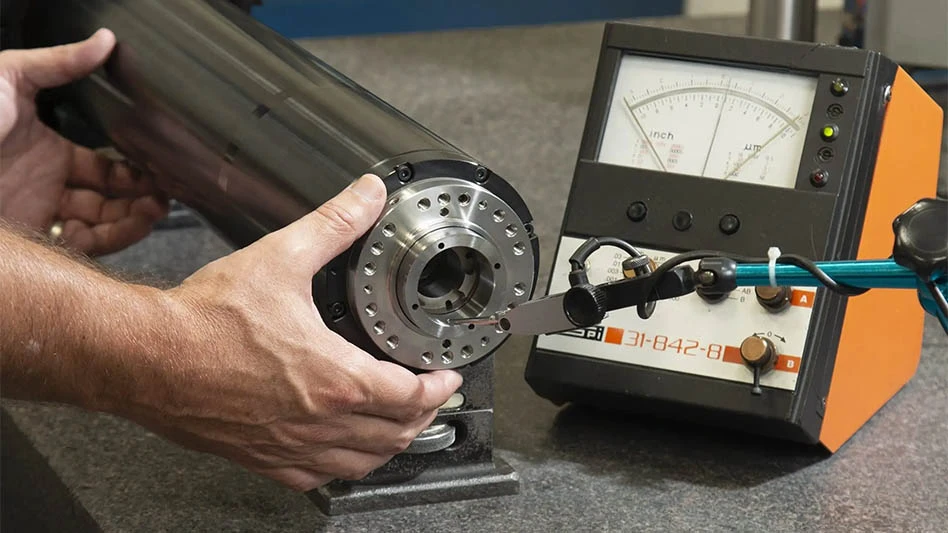
Eiichi Okuma established Okuma Corp. in 1898 in Nagoya, Japan. The first machines produced there were noodle machines, then cigarette rolling machines, and by the early 1900s, machine tools. Today, Okuma produces a vast product line, and in order to meet increased pressure to delivery machine tools faster, facility expansions and upgrades have occurred.
(Left) DS1 started operation in May 2013 and operated 24/7, 365 thanks to investment in automation technologies.
The company’s investment in automation was obvious on my recent trip to the Kani and Oguchi manufacturing facilities in Japan. The Kani plant consists of 1.13 million square feet of space and is the location where the company manufactures its double-column, vertical, and horizontal machining centers, and grinders. Oguchi makes up 1.3 million square feet of facilities with manufacturing multi-tasking machines and lathes occurring there.
(Left) Okuma Machine Fair 2013 ran Nov. 12-15, 2013, and during this time DS1 was open for public tours for the first time.
A highlight to the overseas visit was a tour of the new DS1 facility – located in Oguchi just outside Nagoya. With construction started in May 2012, the new facility was completed and put into operation just 12 months later.
Automation and flexible manufacturing are keys to the advanced productivity in the new facility, which boasts energy-efficient operation as well. DS1 (Dream Site 1) looks like a factory of the future because of its blend of machine technology, automation, and expertise. Operating 24/7, 365 days a year, DS1 has enabled twice the production of machinery with half the lead team previously required while maintaining roughly the same amount of workers.
(Left) DS1 features flexible manufacturing, robotic loading, unattended machining, and rows upon rows of Okuma machines.
Regarding the energy-efficient facility, a quick look at the side of the facility, and photos of the roof of DS1, shows the 5,000+ solar panels installed that are reducing energy costs by 30%. Matching the rest of the plant’s advancements is the software that monitors the efficiency of the solar panels and displays the kWh usage.
The public unveiling of DS1 occurred in conjunction with Okuma Machine Fair (OMF) 2013. OMF 2013 boasted 10 world premier machines, and more than 40 machine tools in all.
While attending OMF 2013, I was able to take time to talk with Yoshimaro (Dean) Hanaki, Okuma’s president and CEO, gathering his thoughts on the future of Okuma and the machine tool industry.
(Left) Okuma has more than 2.16 million square feet of manufacturing facilities in Japan.
When asked about these 10 new machine models unveiled recently by Okuma, Hanaki could not guarantee this pace of innovation every 1-1/2 years, but readily agreed that continually coming out with new models is necessary. Quite often, he said, these models develop directly from customers’ input regarding what they need next in terms of advanced manufacturing technology.
(Left) A look at the side of DS1 shows the wall of solar panels. The new plant boasts more than 5,000 solar panels in all.
Automation was another clear area that Hanaki was eager to discuss. Previous plant operations ran two shifts a day and no weekends. However, with robotic loading of the machine tools, Fastem pallet systems, and aisle upon aisle of Okuma’s own machining centers, DS1 achieves lights-out operation for 24/7 productivity.
(Left) Software monitors power generation from the installed solar panels.
Hanaki also explained that beyond the investment in automation and machines within the facility, there is a lot of software, and hardware behind the scenes that maintains the success realized with DS1. The production control implementation delivers the necessary information to coordinate accurate start to finish scheduling for on-time part delivery to the machines in assembly. Although this is not visible to those of us touring the facility, the result is the elimination of extensive warehousing of parts and the production of parts through final machinery in an expedited manner.
One last note of importance is the emphasis Hanaki places on Okuma’s Intelligent Technology. These performance enhancement features are unique to Okuma and encompass four areas of technology:
- Thermo-Friendly Concept
- Collision Avoidance System
- Machining Navi
- 5-Axis Auto Tuning System
To learn more about Intelligent Technology, click here.
Virtually visit Okuma’s Japan facilities by clicking here.
Latest from Aerospace Manufacturing and Design
- Qatar Airways orders up to 210 Boeing widebody jets
- Digital test indicator offers larger measuring ranges
- AviLease orders up to 30 Boeing 737 MAX jets
- 256-piece general maintenance tool kit
- JetZero all-wing airplane demonstrator achieves milestones
- Cermet indexable inserts for medium turning operations
- Trelleborg acquires Aero-Plastics
- Industrial automation products, enclosed encoders
.JPG)


.JPG)
.JPG)
.JPG)





